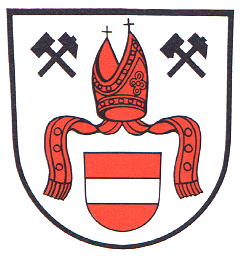Münstertal/Schwarzwald: Difference between revisions
Knorrepoes (talk | contribs) No edit summary |
Knorrepoes (talk | contribs) m (Text replace - "[[Literature" to "{{media}} [[Literature") |
||
| Line 23: | Line 23: | ||
The Austrian shield already appeared on the second seal of the city of Münster, dating from 1417. The older seal only showed a church with a chalice. The church probably symbolised the St. Trudpert Abbey, the chalice was taken from the arms of the Lords of Staufen, who ruled the city from 1277-1602 as vassals for the Dukes of Austria. The city was destroyed in the late 14<sup>th</sup> century and lost its importance. Presently it is the village of Rotte Münster. | The Austrian shield already appeared on the second seal of the city of Münster, dating from 1417. The older seal only showed a church with a chalice. The church probably symbolised the St. Trudpert Abbey, the chalice was taken from the arms of the Lords of Staufen, who ruled the city from 1277-1602 as vassals for the Dukes of Austria. The city was destroyed in the late 14<sup>th</sup> century and lost its importance. Presently it is the village of Rotte Münster. | ||
{{media}} | |||
[[Literature]] : John and Heine, 1989; John, 1994 | [[Literature]] : John and Heine, 1989; John, 1994 | ||
Revision as of 01:57, 9 July 2014
| Heraldry of the World Civic heraldry of Germany - Deutsche Wappen (Gemeindewappen/Kreiswappen) |
MÜNSTERTAL/SCHWARZWALD
State : Baden-Württemberg
District (Kreis) : Breisgau-Hochschwarzwald
Additions : 1971 Obermünstertal, Untermünstertal
Official blazon
In Silber ein erniedrigter roter Wappenschild, darin ein silberner Balken, darüber zwischen zwei schräggekreuzten schwarzen Schlägeln und Eisen schwebend eine rote Mitra mit roten Zierbändern.
Origin/meaning
The arms were granted on July 3, 1972. The arms were created after the merger of Ober- and Untermünstertal.
The small shield shows the arms of Austria, as the area historically belonged to Austria until 1813. The mitre is the symbol of the St. Trudpert Abbey, which had extensive possessions in the valley. The tools symbolise the silver mining in the valley from the 10th century until 1865.
The Austrian shield already appeared on the second seal of the city of Münster, dating from 1417. The older seal only showed a church with a chalice. The church probably symbolised the St. Trudpert Abbey, the chalice was taken from the arms of the Lords of Staufen, who ruled the city from 1277-1602 as vassals for the Dukes of Austria. The city was destroyed in the late 14th century and lost its importance. Presently it is the village of Rotte Münster.
Contact and Support
Partners:
Your logo here ?
Contact us
© since 1995, Heraldry of the World, Ralf Hartemink 
Index of the site
Literature : John and Heine, 1989; John, 1994











